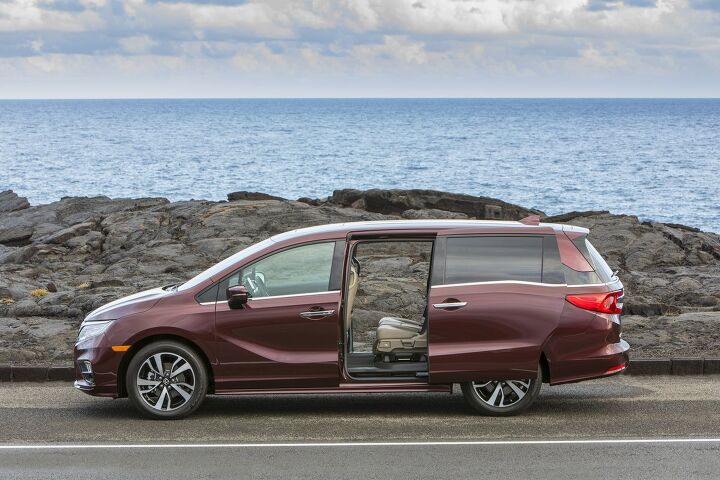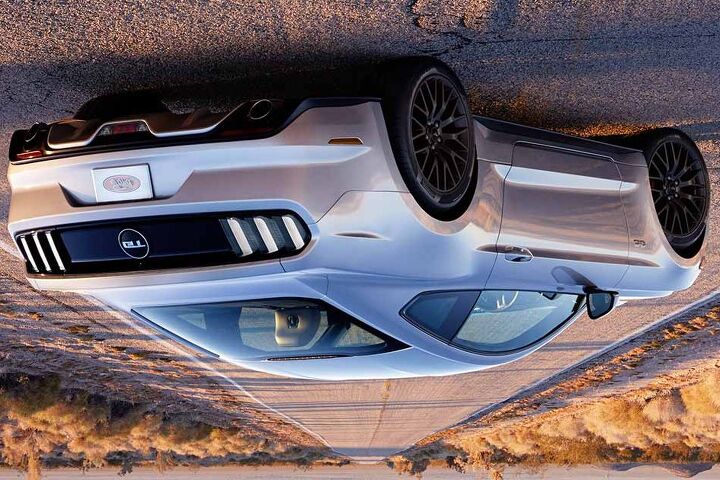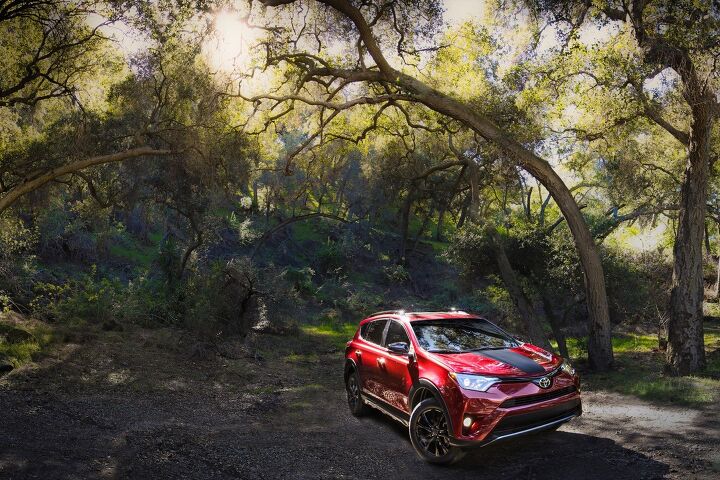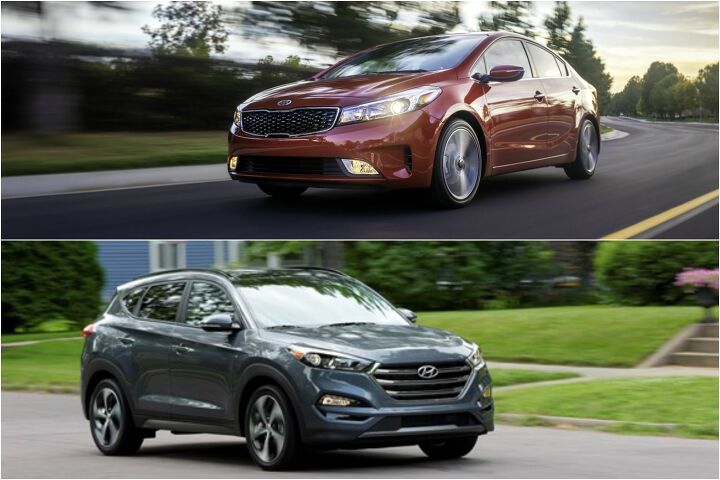#May2017Sales
General Motors' 2017 U.S. Auto Sales Forecast Adjusted (Downward)
General Motors no longer expects the U.S. auto industry to collect more than 17.5 million new vehicle sales in 2017.
GM’s chief financial officer, Chuck Stevens, revisited the automaker’s U.S. sales forecast and turned the wick down from the mid-17-million-unit range, according to Automotive News, to the low-17-million-unit range.
That’s not a low number. In fact, 2017’s reduction of some 300,000 sales across the industry, year-over-year, would produce the second-best year for auto sales since 2001.
But reduced demand is complicating matters for the entire industry, most particularly for large automakers with excessive inventory.
Purists Rejoice: There Will Never Be a Volkswagen GTI SUV; Golf GTI Cruising Along Nicely in America
Got your heart set on a 2018 Volkswagen Atlas, one with upsized wheels, stickier tires, bigger brakes, some red piping around the grille, and tartan seats?
I feel you. But Volkswagen’s illustrious GTI range is not about to co-sign any legislation on the other side of the aisle. Atlas? Tiguan? Tiguan Limited? Touareg? T-Roc? Amarok? Westfalia? Eurovan?
No.
“I think with the three [GTI models] we have now, we are set,” Volkswagen board chairman Herbert Diess told Autocar.
Unfortunately for the United States hot hatch market, however, only one-third of Volkswagen’s GTI lineup actually makes it to America.
Maybe a Tiguan GTI wouldn’t be so bad?
The Real Deal: In 2017, Traditional Body-On-Frame SUV Sales Are Still Rising In America
All across America, Hummer H2s are rolling over in their graves.
What even is a Toyota C-HR? Is the Hyundai Kona an indirect Kia Borrego replacement? The Jeep Renegade shares its platform with… an Italian cute-ute?
But have no fear, dead Hummer. The body-on-frame SUV is here to stay. The surge in crossovers — both the number sold and the number of nameplates available — has not caused the American consumer to leave traditional SUVs behind entirely.
U.S. sales of traditional body-on-frame SUVs are up 7 percent through the first five months of 2017, right on par with the growth rate achieved by the SUV/crossover sector as a whole.
Like GM's Current Midsize Trucks? Good, Because Colorado and Canyon Are Hanging Around Until 2022
General Motors evidently hopes you like the Chevrolet Colorado and GMC Canyon the way they are.
The midsize truck twins, which arrived in second-generation form nearly three years ago, won’t be replaced for another five years.
After a Dreadful Start, 2017's Second Half Is the Minivan's Time To Shine - but Can the Segment Recover?
The 2018 Honda Odyssey went on sale three weeks ago. The Chrysler Pacifica has only been on the market for a year. The Toyota Sienna will enjoy another refresh for the 2018 model year.
If ever there was a time in which America’s minivan segment needs to shine, the second-half of 2017 is it.
Minivan sales tumbled 14 percent, year-over-year, through the first five months of 2017. Only 3 percent of the auto industry’s volume is now minivan-derived. Year-over-year volume decreased in nine consecutive months between August 2016 and April 2017.
There are far fewer competitors now than there were a decade ago. Therefore, the minivan market doesn’t need to produce the sort of volume it did a decade ago. However, minivan sales can’t continue to plummet, month after month after month.
Minivan sales need to rise. If they can’t do so now, then when? And if the segment can’t do it with fresh product from Chrysler, Honda, and Toyota, then who can supply the growth?
The Ford Mustang's New Big Market: Australia
Thanks to the appeal of a modern independent rear suspension and the availability of right-hand drive, the sixth-generation Ford Mustang has encountered far greater global appeal than any Mustang before it.
The latest country to take a real liking to the Mustang is Down Under, where Australians are buying more Mustangs than any other Ford save the Ranger.
And it’s a good thing they are. While U.S. sales of Mustang plunged 28 percent in the first five months of 2017, production at Mustang’s Flat Rock, Michigan, assembly plant hasn’t been forced to slow down nearly that much. Through the first-third of 2017, Ford built only 4-percent fewer Mustangs than in the same period last year.
Put another Mustang on the barbie, indeed.
Vanishing Act: America's 10 Most Rapidly Declining New Vehicles in 2017
The U.S. auto industry is shrinking. But only by a little bit.
Auto sales through the first five months of 2017 are down just 2 percent, a drop of roughly 140,000 sales across the entire industry. Aside from high inventories and rising incentives, it’s not all doom and gloom. 2016 was the highest-volume year in the history of the American auto industry — a 2-percent drop is hardly catastrophic.
This is therefore not 2009, when virtually every new vehicle suffered decreased volume. Many new vehicles are surging, selling significantly more often this year than last.
But in a declining market, many other nameplates are in fact losing sales. Many sales. We’ve compiled a list of the 10 volume nameplates losing U.S. sales most rapidly.
Subaru Is Inoculated Against a U.S. Auto Industry Slowdown - Expect 2017 to Be Another Record Year
Subaru of America set an all-time annual sales record in 2009.
You remember 2009, though you’d likely prefer to forget it.
The auto industry all but collapsed as the global economy went into meltdown. After total U.S. new vehicle sales volume fell to a 25-year low in 2008, sales tumbled a further 21 percent in 2009, the worst year for auto sales since 1982.
And yet Subaru of America set a sales record in 2009.
2017 is no 2009. But after surging to record levels in 2016, the U.S. auto industry’s sales volume is once again shrinking, albeit modestly. But Subaru of America president Tom Doll told Automotive News, “We certainly think we’re going to have our ninth consecutive year of record sales.”
No doubt.
Nobody Backs Out The Outback: Volkswagen Golf Alltrack Sales Momentum Is Slowing Already, But Golf Wagon Totals Are Soaring
You didn’t seriously think there was a tall, be-cladded wagon that could sell like a Subaru Outback, did you?
And you didn’t think — if such a tall, be-cladded wagon did have the potential to sell as well as a Subaru Outback — that it would be a Volkswagen Golf Alltrack?
Of course you didn’t, not in this post-diesel scandal world. But as the all-conquering Subaru Outback continues to enjoy increased U.S. demand, the latest Outback alternative is already suffering a mild case of DTWS.
Not Dancing With The Stars. Don’t read so fast.
Decreased Tall Wagon Sales.
The Volkswagen Golf Alltrack’s May 2017 performance of only 1,312 sales represented a six-month low.
Hyundai U.S. Sales Vice President Derrick Hatami Is Out, Effective Immediately
Updated at 10:00pm on June 6 with response from Hyundai.
Derrick Hatami, Hyundai Motor America’s vice president of sales for less than two years, has been removed from Hyundai’s leadership team as of today, June 6, 2017.
After record annual volume in the 2016 calendar year, Hyundai’s U.S. sales have been falling fast throughout 2017. Year-over-year, Hyundai volume declined in each of the last six months, including an 18-percent decline in May 2017.
That decline enabled partner brand Kia to outsell Hyundai for the first time in the brands’ U.S. history, evidently a source of embarrassment for Hyundai. Having already forced out the company’s U.S. CEO, Dave Zuchowski, just before Christmas last year after Hyundai’s rapid growth stalled, Derrick Hatami’s departure leaves a hole that will be filled in the interim by Hyundai’s southern regional general manager, Sam Brnovich, according to Automotive News.
Last week, Hyundai wasn’t short on excuses for the company’s poor May performance. This week, the excuses were apparently not good enough.
The 2018 Toyota RAV4 Adventure Is No Niche Market Special Edition - It'll Be More Popular Than Most SUVs
In late 2015, Toyota revealed that the automaker’s increasingly popular RAV4 would be increasingly leaned upon for major U.S. sales volume.
As of five years ago, Toyota USA had never sold more than 200,000 RAV4s on an annual basis. Toyota didn’t touch the 300,000 marker until 2015.
But the goal set in 2015 was loftier: 400,000 U.S. sales of the RAV4 in 2018. An SE trim level helped. Then the RAV4 Hybrid became a real success. Toyota sold 352,154 RAV4s in 2016 and is on track for 380,000 sales in 2017.
What will put the Toyota RAV4 over the hump?
If all goes according to plan, the 2018 Toyota RAV4 Adventure that goes on sale in September won’t be a mere oddball offshoot.
Canadian Auto Sales More Numerous Than Ever in May 2017; Canadians Paid More Than Ever, Too
Canadian auto sales surged to record levels in May 2017, surpassing the previous monthly record from April of last year by an 8-percent margin and topping 200,000 units for just the second time in history.
You know it’s going well when, in a virulently anti-car market, passenger car sales increase, year-over-year. And in the fifth month of 2017, car sales did indeed improve, growing 3 percent beyond May 2016 levels.
You know it’s truly going well when, in a market that had already seen pickup truck market share climb to 20 percent, pickup truck sales jumped 38 percent to form 22 percent of the industry’s volume.
And you know it’s going exceptionally well when, in the span of just one month, the relatively small Canadian market purchases and leases 217,000 new vehicles at significantly higher prices than in the past.
Midsize Sedan Deathwatch #12: Is That An Atlas Intruding Into Your Territory?
The Volkswagen Passat has a roomie.
Production of the Volkswagen Atlas, Volkswagen of America’s first three-row SUV and the automaker’s first three-row vehicle since the Dodge Grand Caravan-derived Volkswagen Routan fled the scene in 2014, began earlier this year in Chattanooga, Tennessee, previously known as the Passat’s factory.
The first 1,610 copies of the Atlas were sold in May 2017.
Volkswagen, which built the Tennessee assembly plant as part of a goal that would see the brand selling 800,000 vehicles in America per year by 2018, originally intended to build 150,000 vehicles annually in Chattanooga. Only half that capacity was used last year.
If the Volkswagen Atlas becomes the hit the Volkswagen Passat never was, what might that say about the North Americanized Volkswagen Passat’s future?
How Did Ford Motor Company Outsell General Motors In May 2017?
With its Ford and Lincoln brands, the Ford Motor Company reported 240,250 U.S. sales in May 2017, a 2-percent year-over-year improvement.
General Motors, which has outsold Ford Motor Company in 14 consecutive months, sold 237,364 new vehicles in May 2017, a 1-percent year-over-year drop.
In May 2017, for the first time since March of last year, the Ford Motor Company outsold General Motors.
The Mark Fields era at Ford, a period in which the company’s value crumbled, is over. But if Fields took the blame for what ailed Ford, doesn’t he get the credit for what went right? Besides a handsome severance package, the Mark Fields era ended with Ford Motor Company out in front of General Motors.
But how did Ford make it happen? With pickups and fleets.
The Koreans' American Battle: In May 2017, Kia Outsold Hyundai for the First Time Ever
May 2017 was not a particularly healthy sales month for either of South Korea’s two major automakers in the United States. Including Hyundai’s Genesis spinoff brand, the Hyundai-Kia Automotive Group declined 12 percent, year-over-year — a loss of more than 15,000 sales for the trio of Korean brands compared with May 2016.
Korea’s U.S. auto market share thus fell to 7.8 percent in May 2017, a drop of a full percentage point. In a market that’s seen sales fall 2 percent overall through the first five months of 2017, total Hyundai-Kia Automotive Group sales are down 7 percent following record annual volume in 2016.
Hyundai and Kia both underperformed the market in May, just as they’re both underperforming the market through the first five months of 2017. But by an altogether different standard, one member of the group will be pleased with May’s U.S. sales results.
In May 2017, for the first time in the brands’ U.S. sales history, Kia sold more new vehicles than Hyundai. Kia outsold Hyundai. Yes, it was the first time. But it surely won’t be the last.






























Recent Comments